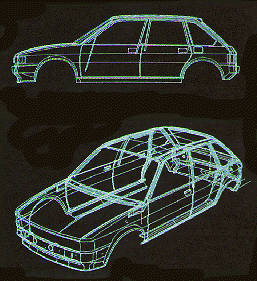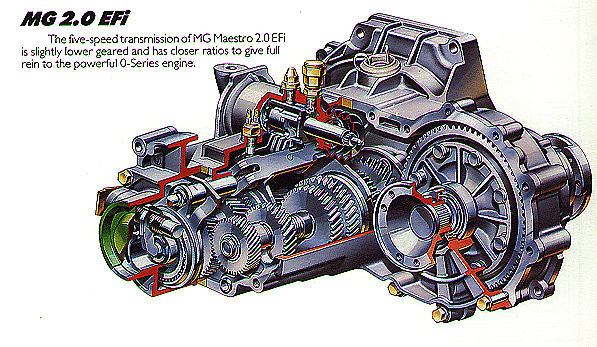|
Bilmodel - Austin/MG Maestro |
||
|
|
||
|
foto: MG Maestro 1986 - Wikipedia © |
||
|
Austin/MG Maestro
 The Metro was planned to be one of a series of cars which BL were to introduce for the 1980's, the next model in size being a larger hatchback called the Maestro. If the Turbo Metro had been a surprise to the general public, then there was absolute amazement that there should be an MG version of this new car. Also, the MG Maestro was introduced right at the start of the new model, which simply underlined the great success of the MG Metro. Production of both the Maestro and later the Montego was at Cowley and not Longbridge.
The Metro was planned to be one of a series of cars which BL were to introduce for the 1980's, the next model in size being a larger hatchback called the Maestro. If the Turbo Metro had been a surprise to the general public, then there was absolute amazement that there should be an MG version of this new car. Also, the MG Maestro was introduced right at the start of the new model, which simply underlined the great success of the MG Metro. Production of both the Maestro and later the Montego was at Cowley and not Longbridge.
 The MG Maestro 1600 was in no way an extra model to make up the range, it was a new model in itself with a more powerful engine and a close ratio gearbox. The engine was a development of the E-series unit, which had been fitted to the much maligned Maxi range, and now re-coded the R-series. A long-stroke engine, with a chain-driven overhead camshaft, it developed a good level of torque but was slightly spoiled by the fact that the MG version was fitted with twin dual-choke carburettors which were notoriously difficult to keep in tune, and hence made the low speed running of the engine rather uneven. Unfortunately, the uprating of the R-series engine was not wholly appropriate for a family saloon, and it soon gained a bad reputation for cutting out and poor starting when hot.
The MG Maestro 1600 was in no way an extra model to make up the range, it was a new model in itself with a more powerful engine and a close ratio gearbox. The engine was a development of the E-series unit, which had been fitted to the much maligned Maxi range, and now re-coded the R-series. A long-stroke engine, with a chain-driven overhead camshaft, it developed a good level of torque but was slightly spoiled by the fact that the MG version was fitted with twin dual-choke carburettors which were notoriously difficult to keep in tune, and hence made the low speed running of the engine rather uneven. Unfortunately, the uprating of the R-series engine was not wholly appropriate for a family saloon, and it soon gained a bad reputation for cutting out and poor starting when hot.
 The rest of the car showed the flair and detailed design of the smaller MG Metro, and the MG Maestro proved to be a popular addition to the range. It too gained a more sporting interior than its counterparts, along with alloy wheels shod with low-profile tyres, and a boot spoiler to add to the sporting appearance of the car.
The rest of the car showed the flair and detailed design of the smaller MG Metro, and the MG Maestro proved to be a popular addition to the range. It too gained a more sporting interior than its counterparts, along with alloy wheels shod with low-profile tyres, and a boot spoiler to add to the sporting appearance of the car.

At the same time as when the MG Montego was introduced (October 84), the MG Maestro EFi had been introduced. They shared the same two-litre fuel-injected engine and five-speed close-ratio transmission, which replaced the somewhat troublesome 1600cc R-series unit.
Some Production HistoryADO-99 was the development project for the Austin Allegro replacement (Maestro), later it was given the designation LM10, and merged with project LM11(Montego)
The LM10 Austin Maestro range was introduced in March 1983.
March 1983 The MG Maestro fitted with a 1598 R-series engine cost a mere £6554!!
July 1984 The new S-series engine was introduced. £6775
October 1984 Maestro Efi introduced, fitted with the 1994cc 'O' series engine. £7279
October 1988*MG Maestro Turbo introduced, production was limited to 5OO, and cost £12,999. The MaestroTurbo was fitted with the exclusive Tickford body

MG Maestro Turbo
 Below is the text from a Press release issued on 17th March 1989 by Impact PR Consultants on behalf of Aston martin Tickford Ltd. It followed the first public view of the MG Maestro Turbo at the October 1988 Motor Show, Birmingham. It coincided with a series of round the country events being held at Rover dealers where an example of the new Maestro Turbo was displayed and available for test drives.
Below is the text from a Press release issued on 17th March 1989 by Impact PR Consultants on behalf of Aston martin Tickford Ltd. It followed the first public view of the MG Maestro Turbo at the October 1988 Motor Show, Birmingham. It coincided with a series of round the country events being held at Rover dealers where an example of the new Maestro Turbo was displayed and available for test drives.
TICKFORD TEAM UP WITH MG TO BUILD NEW TURBO
The new 128 mph MG Turbo brings together two famous names in British motoring history to produce one of the fastest sporting hatchback models on sale today.
The skilled engineering team at Tickford have been working with Austin Rover to turn the Maestro-based turbo model into the fastest accelerating MG model available – with handling and good looks to match.
Having played a key role in developing the car, Tickford are now well underway with the production programme at their Midlands-based specialist manufacturing factory.
The MG Turbo, which accelerates to 60 mph in just 6.7 seconds, was unveiled at the British International Motor Show last Autumn and received an enthusiastic response. Now the car is on sale through the Austin Rover dealer network.
It was Austin Rover who first approached Tickford with the concept of the sporting model making use of the Montego Turbo power unit. Tickford’s team, well used to working on high performance models, then carried out the detail engineering design, development and test programme on the car.
The new model uses Montego Turbo suspension which has been developed by Tickford to give optimum handling and ride comfort. Tickford are also responsible for manufacturing the additional body styling panels which add to the sporting and eye catching appeal of the car.
With the design of the model finalised Tickford then carried out further extensive track and road testing prior to the production start. The main build of the car is carried out by Austin Rover, with the vehicles transferred to Tickford for fitment of the special styling panels.
It is most appropriate that Tickford should work on the new car since going back several decades the names of Tickford and MG were synonymous in producing special bodied high performance sports cars - many of which have survived as valuable collector’s items.
The MG Turbo is also the latest in a long line of special models which have gone through the Tickford design, development and special production facility. The company are unique in their ability to provide this service to mainstream manufacturers.
Commenting on the MG project, Tickford Managing Director John Thurston said: “This new model is one of the most exiting ‘hot hatchbacks’ on the road today. We are proud to once again be working with MG and hope this marks a revival of the association between our two names.”
Tickford, owned by the fast growing C H Industrial PLC Group, are Britain’s leading independent vehicle design, engineering, development and build company. Other current projects being carried out by the company include the design of a unique new five-valve cylinder head to be used by the Camel Team Lotus Grand Prix team this year.
Our thanks to Roger Parker for the above

Reply
Oil leaks if serious WILL be evident from oil dripping from the car. There are a number of considerations depending on the age of your car, which dictates the series of engine you have.
Common to all 'O' series petrol engines there is a weakness in the design. This leads to oil weeping out from the cylinder head gasket in the general area between number 4 plug and the distributor cap. This is due to the oil feed to the head being in the outer area of the block/head, outside the clamping line of the head bolts which allows (over time) flex and a gradual failure of the inbuilt oil seal within the head gasket.
When considering head gasket changes you must obtain the correct gasket for your engine series. The oil drilling position on the block did alter slightly over the years. Examination of some head gaskets will show this with early gaskets having an elongated oil seal, whilst later ones have a small plain circular seal. The later gasket with that type of seal will not be compatable with early engines.
As the history of your engine is probably unknown then at the first opportunity replace the oil and filter. Before draining the oil add a flushing agent from the likes of Halfords or similar. Follow the instructions, but be wary that when you do drain the oil do it hot (and boy will it be hot and thin!) so that you remove as much 'crap' as possible. (watch for the rapid flow and wear protective gloves to prevent scalding) You would be amazed the improvement fresh oil and a filter has on the running of an engine!
Also clean out all the breathers and pipes. Blocked breathers are quite common and this results in excessive cranckcase compression, which in turn leads to oil being forced out of places it shouldn't.
Don't remove the sump until you have cleaned off the engine using a steam or hot jet wash to clean dowm the engine. Keep the spray from directly hitting the electrics but once done any continuing leaks will be immediately obvious, and the rate of loss will be easy to see. A frequent area for leaks can be through the oil pressure sender unit that attaches to the oil pump above the oil filter. This is where oil actually seeps through the sender. Replacement is cheap but don't over tighten as it is a taper thread and a cracked housing means a replacement pump. After all this you will find that the sump bolts will have become loose through shrinkage of the gasket. As a first try just tighten them all evenly.
Rover gaskets are best since the problems have been ongoing for many years and so there have been numerous updated gaskets. (There about 11 different ones for the 'O' series!) Aftermarket gaskets follow early patterns.

Efterfølgeren - Rover 25

